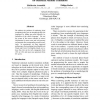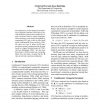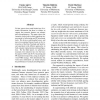ACL
2008
14 years 1 months ago
2008
This paper presents a translation model that is based on tree sequence alignment, where a tree sequence refers to a single sequence of subtrees that covers a phrase. The model lev...
ACL
2008
14 years 1 months ago
2008
This study presents a novel approach to the problem of system portability across different domains: a sentiment annotation system that integrates a corpus-based classifier trained...
ACL
2008
14 years 1 months ago
2008
Previous work on statistical language generation has primarily focused on grammaticality and naturalness, scoring generation possibilities according to a language model or user fe...
ACL
2008
14 years 1 months ago
2008
We address the problem of translating from morphologically poor to morphologically rich languages by adding per-word linguistic information to the source language. We use the synt...
ACL
2008
14 years 1 months ago
2008
Paraphrase patterns are useful in paraphrase recognition and generation. In this paper, we present a pivot approach for extracting paraphrase patterns from bilingual parallel corp...
ACL
2008
14 years 1 months ago
2008
Detecting conflicting statements is a foundational text understanding task with applications in information analysis. We propose an appropriate definition of contradiction for NLP...
ACL
2008
14 years 1 months ago
2008
The standard set of rules defined in Combinatory Categorial Grammar (CCG) fails to provide satisfactory analyses for a number of syntactic structures found in natural languages. T...
ACL
2008
14 years 1 months ago
2008
To date, parsers have made limited use of semantic information, but there is evidence to suggest that semantic features can enhance parse disambiguation. This paper shows that sem...
ACL
2008
14 years 1 months ago
2008
ACL
2008
14 years 1 months ago
2008
We propose a succinct randomized language model which employs a perfect hash function to encode fingerprints of n-grams and their associated probabilities, backoff weights, or oth...




